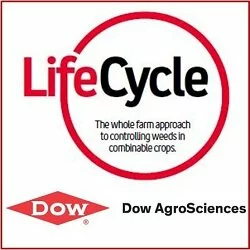Harvest Review 2013
A family farm of over 1,300 ha. with a variety of enterprises plus 360 ha. which we contract farm means that there is a lot going on and, as manager for the whole farm on behalf of the family, I aim to keep the farming operations relatively simple.
On the arable side we work on a 3 year rotation of Wheat, Barley, Oilseed Rape with approximately 400 ha. of each. This is managed with the help of a Foreman, a tractor driver and a couple of part timers. I rely heavily on my agronomist to advise me and do all the background research required to ensure we make the best decisions on varieties and crop protection.
We also have around 260 ha. of permanent pasture for our 330 milking crossbreds. They are grazed intensively and wintered on stubble turnips, yielding on average 5,800 litres. We keep all the dairy heifers and rear them on off lying pasture and downland. The Head Herdsman has an assistant, a part time relief milker and a part time calf rearer to help him.
Like everyone else we endured 12 months of adverse weather from mid-April 2012 through to mid-April 2013, encompassing a shocking harvest and tricky autumn planting. That was capped by cold easterly winds in March and early April 2013 which resulted in crops being backward, gappy and very disappointing. Oilseed Rape planted in August/September 2012 was decimated by slugs and, whilst some of the early drilled bits did OK through the winter and got away, the later bits and those damaged by slugs were knocked back again by cold winds in March. It was quite extraordinary to watch crops die before your eyes with 10 days of Arctic winds. If you had told me on 5 April that we would have our second best harvest ever, I would have snapped your hand off! From some very poor building blocks we got pretty amazing results. With reasonably good weather and lots of sunshine through May, June and July the crops thrived and were energised by it. There was enough moisture, particularly on the chalk, to keep the crops going. From the end of June I was really excited about the wheat yields – the wheat crops looked massive and they didn’t disappoint. OSR is always a lottery and you never quite know, but it did look good, it had podded well and the gaps had filled in quite well. Spring Barley looked solid if unremarkable, though there was nothing wrong with it. When the combine went in the results were pretty much what we expected. I returned from a short break towards the end of July expecting to see the crops droughted out but they looked well and had clearly prospered and made use of the sunshine and had not been knocked back by it.
In the end we had a very respectable harvest with a wheat average of 10.4T / ha. Oakley was the star performer, as it always is; JB Diego was quite good; Santiago was good and Conqueror was very good, surprisingly good in fact as it looked short and thin and gappy but the weighbridge doesn’t lie! Of the four Santiago was probably the least good. The OSR averaged 4T / ha. The early drilled rapes, which had grown really well all year, did 4.5T / ha. whilst the gappier, slug damaged fields came in at 3.5T / ha. The Spring Barley, Propino and Charmay, both averaged 7.7T / ha. and gave us top quality grain. The yield range was 7.3 – 8.3T / ha. on both varieties, so very consistent and rather boringly nothing to report agronomically. We grew 120 ha. Spring Rape: the majority of that (70 ha.) was where we had out wintered cattle and the remainder was where we replaced slug damaged Winter Rape. The Spring Rape was consistently very poor, averaging only 2T / ha. against a budget of 3T, which was disappointing as it had looked well all year. However, it had little effect on the overall harvest average as it was only a small part of the total.
As it was such a dry year we had no disease problems and, in hindsight, could probably have got away with just one fungicide, whereas 12 months ago we should have doubled everything! That’s farming for you but overall there is virtually nothing I would have changed this year.
We have chopped all the straw for the first time this year which has been fantastic, apart from 1,000 bales kept for the dairy, so all the organic matter stays on the land. After the Spring Barley we went straight in using our Vaderstad TopDown with the BioDrill, cultivating down to 200mm and drilling the OSR in one pass. Most of that is up already and recent rains will bring the last fields on. In a couple of weeks’ time we shall run through the wheat stubbles, which still have chopped straw in them, with a stubble rake and then leave that until there has been a good frost in winter. We’ll then use the TopDown to create a seed bed for the Spring Barley. After this year’s rape we put the stubble rake through straight after the combine, cultivating to about 25mm. That has now been sprayed and though we would normally use a Vaderstad Carrier to do a first pass, the ground is too hard for that so we are doing a shallow pass with the TopDown to 75mm. It is slower but is doing the job so we can roll it and will then drill with wheat on about 1 October.
Wheat varieties for next year are Leeds, Horatio, Kielder and Santiago. We have changed several varieties based on my agronomist’s advice. He is a key part of the team and studies all the varieties for me, which saves me masses of time. Interestingly I ordered the seed back in May/June and those four varieties have come up trumps in the NIAB trials this year so it looks as though he has got it right. Oakley wheat is an exceptional variety, as seen this year, but it is prone to Yellow Rust and the agronomists are really scared of it as rust is impossible to control if it does come in. He threw his hands up in horror last year when I told him I wanted to grow it again so I was lucky that it was a dry year this year. In 2012 harvest it was rubbish but in 2011 it did 12T / ha. on our farm and this year we had 11.5T / ha which was exceptional. However it is now unfashionable and NIAB doesn’t even list it. Rape varieties are PT211, DK Camelot, Quartz, Fashion and a brand new variety from United Oilseeds being tried by their ‘Beacon farmers’ to see how it goes We grew the first two last year plus PR46, which is a very good variety, and Cabernet. Barley varieties will probably be the same again – Propino and Charmay.
We have a close relationship with Gledhill’s grain merchants and have done trials for them over three years. We also work closely with United Oilseeds as they are close by and the MD drives through the farm every day on his way to work! We market all our oilseeds through their pools and Salisbury Cereals markets all our cereals so that takes me out of the equation and I have someone else to blame if things go wrong on that front!








 Saving...
Saving...
Add a comment
You must be logged in to post a comment.